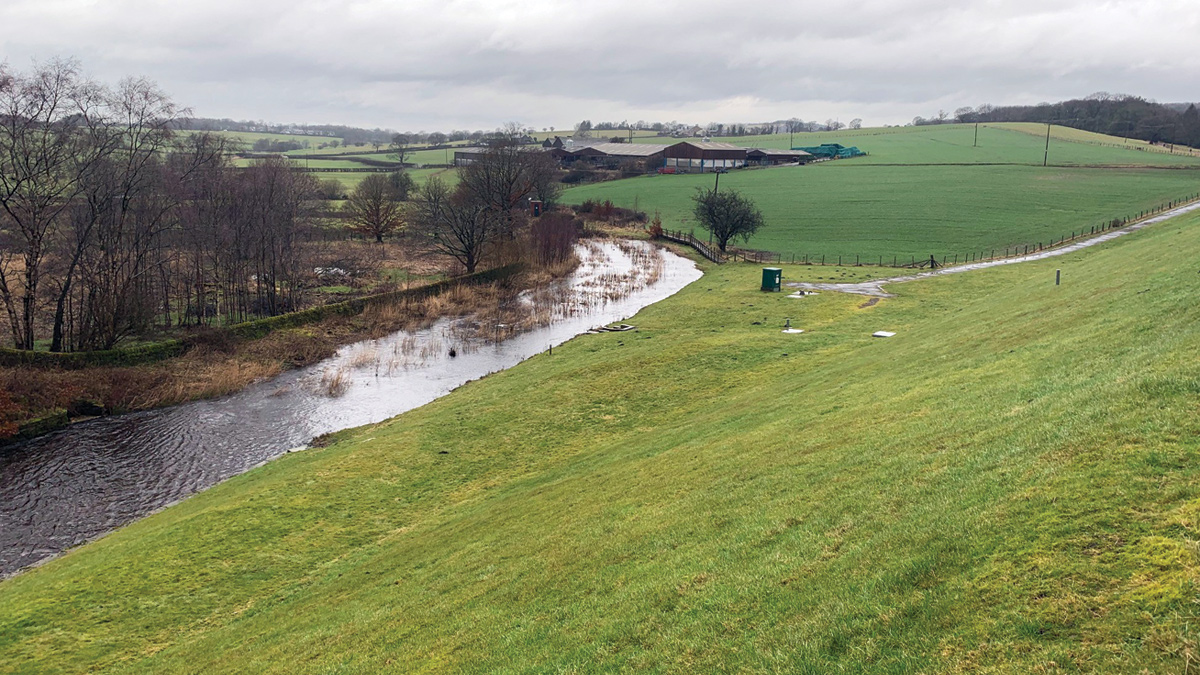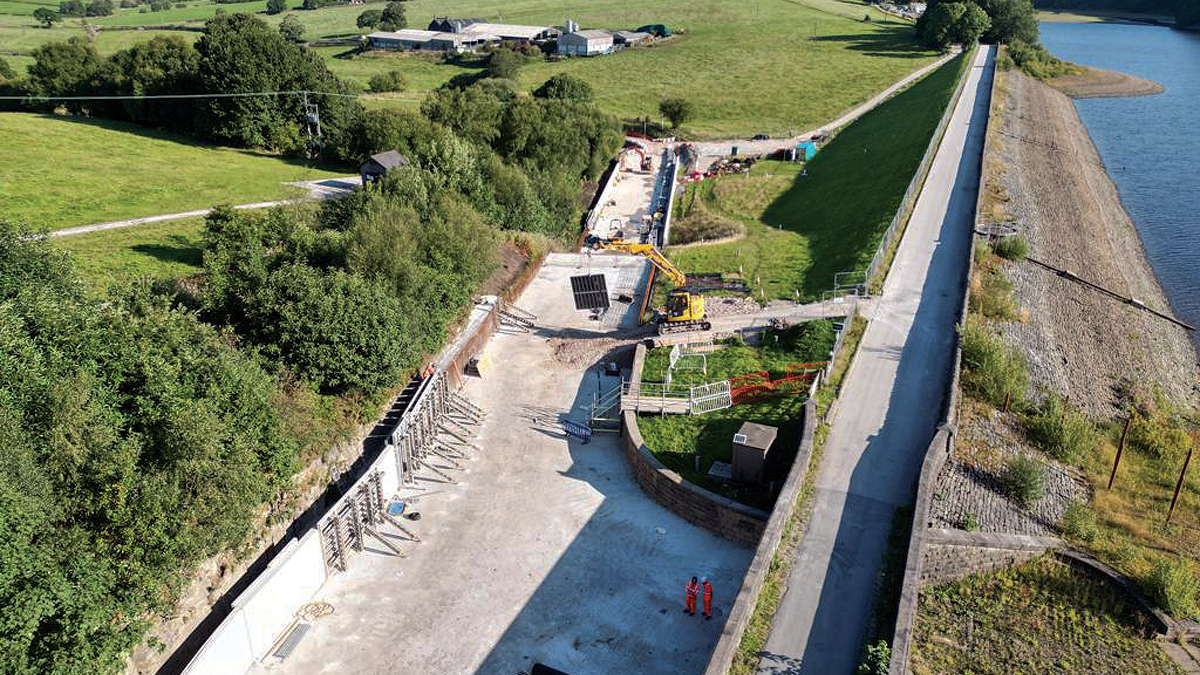Rivington Upper Impounding Reservoir (2023)

(left) Rivington spillway under construction and (right) Ramp leading to lower spillway - Courtesy of Costain
United Utilities and Managed Service Provider (MSP) Costain have delivered improvements to the existing spillway at Rivington Upper Impounding Reservoir in Lancashire. The team worked collaboratively, undertaking a complex construction programme in challenging conditions, while managing the operational needs of the reservoir site and popular recreational area. The main objective was to upgrade the existing spillway. This was driven by a requirement to meet regulatory reservoir protection enhancement requirements.
The remedial works required comprised:
- Works to the spillway to allow the design flood Probable Maximum Flood (PMF) plus air bulking to be safely passed down the spillway and prevent establishment of vegetation
- Protection to the toe of the Yarrow embankment and provision of a reinforced concrete (RC) base to reduce the probability of it being damaged in a PMF.
A compensation flow of 1.223Ml/d was to be maintained during the works and levels in feeding reservoirs were to be held down by 1.5m to enable the works to progress. A scour flow not exceeding 100M/ld was diverted around the working areas in the lower spillway.
Early involvement in the design process
A physical model was produced to illustrate the flow levels down and across the spillway, which determined the new wall heights and gradients down the spillway.
Early engagement between MSP design and construction teams meant that options for construction methods and flow diversions were discussed and assessed for viability. The preferred solution was presented to the Independent Qualified Civil Engineer who was able to comment and challenge the solution. The nature of the scope and working environment offered significant challenges which through collaborative planning and design meetings, the team overcome to meet the regulatory date.
A key priority on such a project is to ensure operational requirements are maintained appropriately throughout construction. Costain worked on various phasing plans to manage flows whilst achieving the regulatory output. The project team engaged regularly with United Utilities catchment controllers to manage the flows safely during construction, ensuring necessary temporary diversions were managed and in place. A flood contingency plan was developed and reviewed regularly to establish a triggered response to rising water levels and ensure the safety of all workers and minimise potential damage to the works.
The job was completed successfully with an exemplary health and safety record with no reportable incidents.

The existing spillway prior to the work – Courtesy of Costain
Rivington Upper IR Improvements: Supply chain – key participants
- Client: United Utilities
- Designer: Costain
- RC works: Westshield Ltd
- Masonry wall construction: JVT Construction
- Handrailing & gates installation: Pure Utility Solutions
- Valves: Glenfield Invicta
- Fencing & landscaping: Lowther Forestry Group Ltd
Construction methods
Due to damage caused to the spillway from previous storm events, and the need to tie in with the existing spillway levels, much of the existing sandstone rock base needed to be broken out prior to construction of the new reinforced concrete spillway.
To reduce loadings and vibration on the dam, the preferred solution was to use hydro-demolition to reduce the level safely without jeopardizing the embankment and other surrounding structures. This method allowed the team to prepare the spillway for the new construction safely and cause less disruption than traditional rock breaking methods.
Another key temporary works solution deployed was to divert scour flows up to 100Ml/day around the working area. This required temporary dam structures and sequence planning to allow the project to construct the spillway walls and base on to land that was previously a riverbed. The lower spillway (approximately 90m in length) was split in half, on one side we created a ditch along with a line of 100 Visqueen wrapped sandbags in order to carry scour flows around the working area and out to river whilst the other side was excavated and the RC base constructed.
Upon completion of the works on one side, the temporary dams were moved over to divert flows onto the newly constructed base. This then allowed the opposing side to be completed, working safely away from the diverted water whilst ensuring the embankment was protected.

Looking down the new spillway – Courtesy of Costain
Sustainability
Rivington Upper Reservoir was one of the first batch of projects to form part of Costain’s baseline initiative; part of the wider WiiSE Strategy launched in 2022 focussing on the company’s approach to climate change, Wellbeing and Inclusion. The initiative looked at materials used and operation consumables including the use of petrol diesel, with a view of achieving a reduction in carbon during the construction programme. The project targeted a 10% reduction vs the baseline and with reductions in the thickness of slabs and walls and the introduction of HVO instead of diesel the project is predicted to achieve that reduction target.
Collaboration
Costain were granted early contractor involvement, enabling the team to work alongside United Utilities at the early stages. This allowed constructability issues to be highlighted and challenged early in the process. Alternate alignments to the outline design were suggested to reduce significant temporary works requirements, whilst saving time and cost in the construction period. This included reducing the spillway width by proposing double sided wall shutters in certain areas instead of the outline scope to use single sided shutters against the existing wall which was in poor condition and had restricted access.
Another collaborative solution which involved both client and contractors was to provide a way of capturing and measuring flows that historically leaked through the rock formed spillway. The design team was able to design and construct a series of under slab drains capable of capturing water penetrating through the rock and providing an outfall where they can be safely measured and inspected to check for potential issues with the embankment.
Costain and United Utilities worked collaboratively, from ECI works, to regular collaborative planning and progress meetings to ensure all information and suggestions were openly shared and discussed to ensure the best solution was put forward.
Completion
Effective temporary works and phasing were key to delivering the project on time, whilst working in challenging conditions and managing the operational needs of the reservoir site. The formal spillway base and walls in the lower spillway were completed in the winter months, dealing with scour flows successfully.
Rivington is popular with walkers, cyclists and other users. The team were able to successfully manage the PRoW, providing a safe alternate diversion route for the public and ensuring the road was open and suitable each night, minimising disruption to the local community.
A robust flood contingency plan was key to delivering the project successfully. From the outset a collaborative plan was formed and constantly reviewed to ensure its effectiveness. Extensive monitoring and measuring of surrounding reservoirs allowed the team to plan for flood events and ensure sufficient time was available to clear the works area in preparation of flood events.





